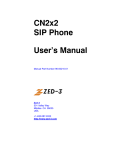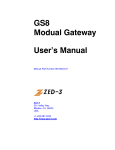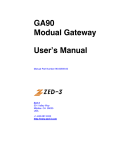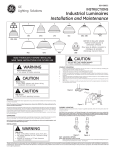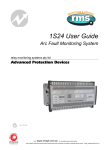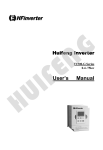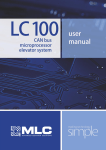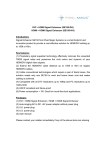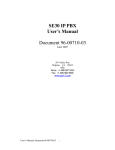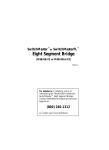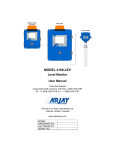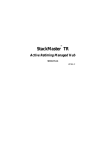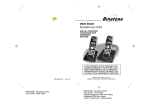Download CN2x4 SIP Phone User's Manual
Transcript
CN2x4 SIP Phone User’s Manual Manual Part Number 96-00213 Zed-3 501 Valley Way Milpitas CA 95035 USA +1-408-587-9333 http://www.zed-3.com Notice The information contained in this document is subject to change without notice. Zed-3 makes no warranty of any kind with regard to this material, including, but not limited to, the implied warranties of merchantability and fitness for a particular purpose. Zed-3 shall not be liable for errors contained herein or for incidental or consequential damages in connection with the furnishing, performance, or use of this material. Zed-3 assumes no responsibility for the use or reliability of interconnected equipment that is not furnished by Zed-3. This document contains proprietary information which is protected by copyright. The contents of this manual and the associated software are the property of Zed-3, and all rights are reserved. No part of this document may be photocopied, reproduced, stored in any computer format, translated to another language, or publicly displayed without the prior written consent of Zed-3. The information contained herein has been prepared by Zed-3 solely for use by Zed-3’ss employees, agents, and customers. Dissemination or use of the information or concepts contained herein to or by other parties is prohibited without prior written consent from Zed-3. Zed-3, the Zed-3 logo, the Zed-3 mark,GS8, CN2x2, CN2x4, SE150, SE150P, SE150+, SE150, SE500, and SEME are trademarks of Zed-3 and may be registered trademarks in certain countries. All other names may be trademarks or registered trademarks of their respective owners. Revision History Release Release Date 0.1 13 June 2008 Contents Product Introduction . . . . . . . . . . . . . . . . . . . . . . . . . . . . . . . . . . . . . . . . . . 1 1.1 Product Introduction . . . . . . . . . . . . . . . . . . . . . . . . . . . . . . . . . . . . . . . . . . . 1 1.2 Profile And Buttons . . . . . . . . . . . . . . . . . . . . . . . . . . . . . . . . . . . . . . . . . . . . 2 Installation . . . . . . . . . . . . . . . . . . . . . . . . . . . . . . . . . . . . . . . . . . . . . . . . . . 9 2.1 Checklist . . . . . . . . . . . . . . . . . . . . . . . . . . . . . . . . . . . . . . . . . . . . . . . . . . . . . . 9 2.2 Installation . . . . . . . . . . . . . . . . . . . . . . . . . . . . . . . . . . . . . . . . . . . . . . . . . . . 10 2.3 Acquire IP Address . . . . . . . . . . . . . . . . . . . . . . . . . . . . . . . . . . . . . . . . . . . . 11 2.4 Web Settings . . . . . . . . . . . . . . . . . . . . . . . . . . . . . . . . . . . . . . . . . . . . . . . . . 12 2.5 Change Language. . . . . . . . . . . . . . . . . . . . . . . . . . . . . . . . . . . . . . . . . . . . . 12 Phone Function . . . . . . . . . . . . . . . . . . . . . . . . . . . . . . . . . . . . . . . . . . . . . 3.1 LCD Display Descriptions. . . . . . . . . . . . . . . . . . . . . . . . . . . . . . . . . . . . . . 3.2 Menu Structure . . . . . . . . . . . . . . . . . . . . . . . . . . . . . . . . . . . . . . . . . . . . . . . 3.3 Menu Functions . . . . . . . . . . . . . . . . . . . . . . . . . . . . . . . . . . . . . . . . . . . . . . 3.4 Phone Settings. . . . . . . . . . . . . . . . . . . . . . . . . . . . . . . . . . . . . . . . . . . . . . . . 3.5 Keyboard Coding Rules. . . . . . . . . . . . . . . . . . . . . . . . . . . . . . . . . . . . . . . . 15 15 16 18 19 22 Phone Usage . . . . . . . . . . . . . . . . . . . . . . . . . . . . . . . . . . . . . . . . . . . . . . . 4.1 Making Calls . . . . . . . . . . . . . . . . . . . . . . . . . . . . . . . . . . . . . . . . . . . . . . . . . 4.2 Answer Calls . . . . . . . . . . . . . . . . . . . . . . . . . . . . . . . . . . . . . . . . . . . . . . . . . 4.3 In Calling . . . . . . . . . . . . . . . . . . . . . . . . . . . . . . . . . . . . . . . . . . . . . . . . . . . . 4.4 Do Not Disturb . . . . . . . . . . . . . . . . . . . . . . . . . . . . . . . . . . . . . . . . . . . . . . . 4.5 Call Forwarding . . . . . . . . . . . . . . . . . . . . . . . . . . . . . . . . . . . . . . . . . . . . . . 4.6 Check Call History . . . . . . . . . . . . . . . . . . . . . . . . . . . . . . . . . . . . . . . . . . . . 4.7 Phone Book . . . . . . . . . . . . . . . . . . . . . . . . . . . . . . . . . . . . . . . . . . . . . . . . . . 4.8 Call Volume Adjustment . . . . . . . . . . . . . . . . . . . . . . . . . . . . . . . . . . . . . . . 4.9 SMS . . . . . . . . . . . . . . . . . . . . . . . . . . . . . . . . . . . . . . . . . . . . . . . . . . . . . . . . . 4.10 Voice Mail Box. . . . . . . . . . . . . . . . . . . . . . . . . . . . . . . . . . . . . . . . . . . . . . . . 4.11 Restore Factory Configuration . . . . . . . . . . . . . . . . . . . . . . . . . . . . . . . . . . 23 23 28 30 33 34 35 36 37 37 38 38 Web Login. . . . . . . . . . . . . . . . . . . . . . . . . . . . . . . . . . . . . . . . . . . . . . . . . . 39 5.1 Login . . . . . . . . . . . . . . . . . . . . . . . . . . . . . . . . . . . . . . . . . . . . . . . . . . . . . . . . 39 5.2 Privilege Difference Between Administrator And Common User . . . . 40 5.3 Change Language. . . . . . . . . . . . . . . . . . . . . . . . . . . . . . . . . . . . . . . . . . . . . 40 Status . . . . . . . . . . . . . . . . . . . . . . . . . . . . . . . . . . . . . . . . . . . . . . . . . . . . . 43 Configurations . . . . . . . . . . . . . . . . . . . . . . . . . . . . . . . . . . . . . . . . . . . . . . 45 7.1 Preference . . . . . . . . . . . . . . . . . . . . . . . . . . . . . . . . . . . . . . . . . . . . . . . . . . . 46 CN2x4 SIP Phone User’s Manual 1 Contents 7.2 7.3 7.4 7.5 7.6 Network Configuration . . . . . . . . . . . . . . . . . . . . . . . . . . . . . . . . . . . . . . . . Call Settings . . . . . . . . . . . . . . . . . . . . . . . . . . . . . . . . . . . . . . . . . . . . . . . . . . Phone Settings. . . . . . . . . . . . . . . . . . . . . . . . . . . . . . . . . . . . . . . . . . . . . . . . Save Modification . . . . . . . . . . . . . . . . . . . . . . . . . . . . . . . . . . . . . . . . . . . . . Cancel Modification . . . . . . . . . . . . . . . . . . . . . . . . . . . . . . . . . . . . . . . . . . . 49 50 63 67 67 Phone Book . . . . . . . . . . . . . . . . . . . . . . . . . . . . . . . . . . . . . . . . . . . . . . . . 8.1 Check Phone Book . . . . . . . . . . . . . . . . . . . . . . . . . . . . . . . . . . . . . . . . . . . . 8.2 Add A New Record. . . . . . . . . . . . . . . . . . . . . . . . . . . . . . . . . . . . . . . . . . . . 8.3 Edit or Delete Records . . . . . . . . . . . . . . . . . . . . . . . . . . . . . . . . . . . . . . . . . 69 69 70 70 Tools . . . . . . . . . . . . . . . . . . . . . . . . . . . . . . . . . . . . . . . . . . . . . . . . . . . . . . 9.1 Upgrade Online . . . . . . . . . . . . . . . . . . . . . . . . . . . . . . . . . . . . . . . . . . . . . . 9.2 Change Password . . . . . . . . . . . . . . . . . . . . . . . . . . . . . . . . . . . . . . . . . . . . . 9.3 Backup/Recover Configurations . . . . . . . . . . . . . . . . . . . . . . . . . . . . . . . . 9.4 Recover Factory Configuration . . . . . . . . . . . . . . . . . . . . . . . . . . . . . . . . . 9.5 Reboot System . . . . . . . . . . . . . . . . . . . . . . . . . . . . . . . . . . . . . . . . . . . . . . . . 73 73 74 75 75 76 How to use headset . . . . . . . . . . . . . . . . . . . . . . . . . . . . . . . . . . . . . . . . . . 77 2 CN2x4 SIP Phone User’s Manual 1. Product Introduction Chapter 1 Product Introduction 1.1 Product Introduction Figure 1-1 • • SIP Phone Appearance Standard SIP Speech codec for VoIP 1 CN2x4 SIP Phone User’s Manual • • • • • • • Full-duplex speakerphone with echo cancellation 10/100Base-T Ethernet Port, use RJ-45 interface Integrated Ethernet automatic toll switching repeater for PC connection Downloadable firmware for further upgrade IP address allocation - DHCP client or static settings Full-duplex handfree speakerphone 26 buttons includes five standard function buttons, one menu button and one phone book button. • • • • • • • • • • • • • • • • 3* 16 screen shows date, time and phone number etc • Supports VoIP under extreme network conditions. For example, packet loss rate is up to 40% and network delay is up to 500ms. • • • ToS bit supported for improving QoS in manageable network. Handfree function with frequency-domain echo cancellation Network Bridge - Ethernet Hub with 2 ports 6-level handfree volume 6-level speech volume 6-level ring volume and silence. 4 ring types 4-level screen brightness Coming call indication, received call list, outgoing call list and call history Re-dialing, flashing, silence, transfer functions Phone book DDNS supported NTP service and multi-DNS service supported Manu- and auto- speech codec negotiation G.711, G.723.1, G.723.1A, G.729A and G.729B speech coder Advanced speech processing: self-adaptable jitter buffer processing in case of package delay and package jittering Friendly user management interface. Implement managmet and configuration via keypad or Web Management System. 1.2 Profile And Buttons 1.2.1 Front View 2 1. Product Introduction Figure 1-2 1.2.2 Front view of the panel Bottom View Figure 1-3 Bottom view 3 CN2x4 SIP Phone User’s Manual 1.2.3 Structure Figure 1-4 1.2.4 Button Descriptions Table 1-1 4 SIP Phone's structure Button Descriptions Button Name Decription 0 - 9, *, # Digit number Digits, * ,# for common use < Menu > Menu button Enter menu mode when the phone is idle < OK > Confirmation button Call out after dialing numbers. < Esc > Return button Confirm operations in menu. 1. Product Introduction Table 1-1 Button Descriptions Button Name Decription <▲> Page up button In menu: <▼> <W> Page down button Move left button • Move to previous item. • Move to previous one when viewing call records • Tune to upper-level volume In menu: • Move to next item • Move to next one when viewing call records • Ttune to lower-level volume In menu, move to the left item In idle state, tune down the LCD gray scale In handfree mode, headset mode or in conversation, tune down the volume. < X> Move right button In menu, move to the right item In idle state, tune up the LCD gray scale In handfree mode, headset mode, or in conversation, tune up the volume. < Msg > Voice mailbox button Listen to the voice mails. < Hold > Hold button Hold the ongoing conversation temporarily < Conf > Conference button Build up 3-parties conferrence < Transfer > Transfer button Transfer a call to another number < Mute > Silence button Close speaker temporarily < Speaker > Speakerphone button In handfree mode, make a call via the speakerphone. < Redial > Redialing button Redial the last numbe <Phone book> Self-defined button Execution of self-defined function buttons, the defaults are: <Forword> <Phone book>:search, add new number in phone book or use speed dialing. <DND> <Forword>:forward always <Park/Picku p> <DND>:do-not-disturb. <Park/Pickup>:in conversation, check or pick up waiting call via "pending call list" function. <Call list> <Call list>:record call history. For more information, see 7.4 Phone Settings <Call1> ~ < Call 4> Line select button Select different line to make a call via handfree speakerphone or headset; in conversation, the button can be used to switch between 2 calls. < Headset > Headset button In headset mode, you may make a call without the handle. 5 CN2x4 SIP Phone User’s Manual 1.2.5 Indicator Descriptions The upper right indicator flashs in different mode based on different phone status. As next table: Table 1-2 Indicator Descriptions LED Color Position Status Description Phone status indicator red On the upper right corner Flashing quickly Ringing when it has a coming call Flashing slowly New missed call if you set "missed call indication" Have a new voice mail 1.2.6 Handfree indicator red Headset indicator red Line indicator red On System is booting (before registry) Off No message (unread) Above <speaker> button On Calling via the speakerphone Off Do not use handfree mode Above <headset> button On Calling via the headset Off Do not use headset mode Above <Call1> ~ <Call4> buttons Flashing slowly When a call is waiting On In conversation Off No use LCD Screen Descriptions Table 1-3 LCD screen descriptions Name Operation/status Display LCD screen In idle state Register successfully "Year - month - day hour:minute:second SIP PHONE xxxx (extension number)" off-hook Line 1 to 4 calling " calling xxxx (extension number)" callee is busy "Line is busy" in conversation "xxxx (extension) 00:00:00 (duration)" <Menu> 6 On-hook after calling "call end" Press this button in idle state Menu item 1. Product Introduction Table 1-3 LCD screen descriptions Name Operation/status Display <Msg> Press this button in idle state Voice mail menu < Hold > Press this button in calling "call holding" < Headset > Press this button in idle state Display: "connecting: xxxx (extension) 00:00:00 (duration) Headset" < Mute > Press this button in conversation "mute 00:00:00 (duration)" < Redial > Press this button in idle state Show the last dialed number, call it via speakerphone. Press this button in off-hook state Redial the last dialed number or call the number showed in LCD screen. Press this button in idle state In handfree mode: < Speaker > Display: "line 1 to 4" < ▲ >/< ▼ > buttons Press this button in idle state Display outgoing numbers Press this button in conversation Volume adjustment Display: "HANDSET?xxxx " In menu or phone book mode Select menu item; Display: ""menu" and "xxxx (extension)" 7 2. Installation Chapter 2 Installation The steps are: • • • • • • • • 2.1 Unpack the case. Component assembly Power on Acquire an IP address for SIP phone Input IP address in browser's address filed. Login on SIP phone's Web Management System Set phone parameters. Save settings and reboot the system. Checklist Check the accessories in the box based on the checklist. The checklist is: 9 CN2x4 SIP Phone User’s Manual Figure 2-1 2.2 Installation • Choose a dry ventilated place to place the phone, right side is up. Connect to 10Mpbs or 100Mpbs network via RJ45 terminal, like LAN, Ethernet broadbank access, ADSL, or Cable Modem access. Please confirm the connection before power-on. Wrong power adapter will damage the phone set. Good connection with ground reduces voltage surge caused by lightning and improves speech quality, so make it sure. (check the connection with ground when speech quality is not good enough ) • Installation steps: As below: 1). Connect the handle and the base: plug one terminal of the telephone cord into the handle port, another one into the port of the base. 2). Connect the phone with network: plug one terminal of the Ethernet cable into the Ethernet port on the bottom side of the phone, plug aother terminal into the port of a switch, a hub, a DSL router, a Cable modem or other equipment. 10 2. Installation 3). Power on: place the phone near power jack, connect the phone with the power cable. After installation, the screen shows this: xxxx-xx-xx(年-月-日) xx:xx:xx(时:分:秒) xxxx-xx-xx(year-month-day) xx:xx:xx(hour:minute: second) SIP PHONE CONNECTING SERVER 2.3 Acquire IP Address The sip phone will acquire IP address actively from DHCP server after connecting with network. You can check the IP address like this: Like below: 1. press <Menu> to enter the menu; 2. press <4>, or use <▲>/<▼> to choose [SYSTEM TOOLS], press <OK> to enter. 3. press <1>, or use <▲>/<▼> to choose [PHONE STATUS], press <OK> 4. press <1>, or use <▲>/<▼> to choose [LAN PORT] and press <OK> 5. press <1>, or <OK> to display LAN PORT information ( like 192.168.200.204 ) LAN PORT 1.STATUS:WORKING 2.IP:192.168.200.204 Note: The IP address is any valid address (between 0 to 255). 11 CN2x4 SIP Phone User’s Manual 2.4 Web Settings Via the build-in Web Management System to complement the initial configuration for CN2x4 SIP Phone. 1. Obtain IP address: To login on Web Management System, you need to know the IP address of network and PC. (set it as above ) 2. Login on Web Management System: Input the IP address in the browser's field. The default username and password are "admin" and "0000". Figure 2-1 is the main page after login. The left part is menu navigator, and the right part is the editing area for parameters. 3. complete the basic configurations: For the basic call functions, you need only three steps: - Allocate phone number and display name for the phone. - Set SIP Proxy and SIP Registrar. - Set Authentication ID and Password These items are all filled in Configurations > Call Settings. Note: save it after modification by clicking Configurations> Save . More information in Part of Web Management System. 2.5 Change Language The default language is English when start-up. CN2x4 SIP Phone supports multi-language. You can use function button or Web Management System to change it. By this way: • Via function button: 1). Press <Menu>, then the LCD screen shows the menu. 2). Press <5>, or use <▲>/<▼> to choose [DEVICE CONFIG] , press <OK> to enter it. Input user name and password. Note: Note: if the "menu configuration passworkd" is disabled, do not need to input user name and password when setting via function button. The default user name and password is "admin". a. Press <Del> to delete user, press "admin" 12 , , , , to re-input username 2. Installation Figure 2-2 Web Management System Showed in the screen: USER NAME: admin b. Press <OK> to show: 13 CN2x4 SIP Phone User’s Manual PASSWORD: c. Press digit buttons, reinput password "0000"; 3). press <OK> to enter [DEVICE CONFIG] sub-menu: a. Press <1>, or use <▲>/<▼> to choose?PREFERENCE] and press <OK> ; b. Press <1>, or use <▲>/<▼> to choose?LANGUAGE] and press <OK>; c. Press <1>, or <OK> to show the LANGUAGE information. d. Press <1>/<2> or use <▲>/<▼> to choose one language ( for example: "SIM. CHINESE"means Simplified Chinese ). LANGUAGE 1. [ ] ENGLISH 2. [+ ] SIM. CHINESE 4). press <Esc> to exit gradually after setting. 5). press <1> or use <▲>/<▼> to choose?SAVE] and press <OK> to save the settings. Note: reboot the system to make the settings work. Turn off power to restart the equipment after changing language mode. • Via Web Management System: 1). login on Web Management System; 2). Change the language: press Configurations > Preference to enter the page, change Language to SIM Chinese for example. 3). Press Configurations > Save Changes to save it. 4). Press Tools > Reboot to reboot the equipment. 14 3. Phone Function Chapter 3 Phone Function 3.1 LCD Display Descriptions • Date and time On the upper left corner of the LCD screen is current date and time which are got from NTP Server automatically based on your settings. About how to set NTP server, see Part III Web Management System please. • Missed calls The message is like this when there are missed calls: X CALLS MISSED Explaination: X is the nubmer of missed calls Press <OK> to check the missed calls, the information includes coming time and caller number. Use <▲>/<▼> to check next one. • Menu display In menu mode, the screen shows all menu items, press <▲>/<▼> and <OK > to choose it. • Call display 1). Show these information when you have a coming call: Caller name or number 00:00:00 (duration) 15 CN2x4 SIP Phone User’s Manual 2). The screen shows these information in conversation: xxxx ( caller ID ) 00:00:00 (duration) 3). The screen shows these information when you hang up the call. Call End Duration: 3.2 。 00:00:00 Menu Structure Press <Menu> to enter the menu mode when the phone is in idle state. The phone quits the menu when there is a coming call or picking up the handle. Or quit the menu automatically after 15 seconds since last operation. The menu's structure is: 16 3. Phone Function Figure 3-1 Web Management System main interface 17 CN2x4 SIP Phone User’s Manual 3.3 Menu Functions Table 3-1 Menu item 1 2 Phone Menu Function Introduction Main menu CALL HISTORY PHONE 1-level sub-menu 2-level sub-menu Function PROFILE 1~4 ANSWERED CALLS Record the number and the time of answered calls CALLS MISSED Record the number and the time of calls missed DIALED CALLS Record the number and the time of dialed calls DELETE ALL Delete all records VIEW Check calls in phone book (includeing name and number) ADD NEW Add new entry SMS PROFILE 1~4 Check or send SMS VOICE MAIL PROFILE 1~4 Enter voice mail box PHONE STATUS LAN PORT Check LAN port's status and the IP address PC PORT Check the connection between PC and outside PHONE NUMBER Check line numbers( up to 4 numbers. ) HW INFO Check hardware information PROFILE 1~4 BOOK 3 4 18 MESSAGE CENTER SYSTEM TOOLS ONLINE UPGRADE Update software online SYSTEM VERSION Check current version RESET CONFIG Restorer factory configuration RING TYPE Set ring type of coming calls RING VOLUME Set ring volume of coming calls CALL FORWORD Set forward object and conditions DEF. HANDFREE DEV. Set default device of handfree mode. 3. Phone Function Table 3-1 Menu item 5 Phone Menu Function Introduction Main menu DEVICE CONFIG 1-level sub-menu 2-level sub-menu Function PREFERENCE LANGUAGE Set language( English or Chinese ) TIME ZONE Set time zone TITLE ON LCD Set display name in idle state ( may be extension number ) DATETIME SVR Set time server's IP address AUTO CONFIG Enable or disable auto-config, includeing auto-config server and auto-update interval. DNS Set domain's IP adress GATEWAY Set gateway's IP address PC PORT Set PC's IP address LAN PORT Set LAN's IP address DISABLE Disable DNS service GATEWAY Set gateway's IP address DNS ADDR Set DNS Server's IP address SUBNET MASK Set DNS Server's netmask for STARTING ADDR Set the valid address extent for domain NETWORK CFG DHCP SERVICE ENDING ADDR 3.4 Phone Settings 3.4.1 Network Settings Visit Menu > System Configurations > Network Configuration to set network parameters. 3.4.1.1 System Configuration Menu Only administrator is permited to enter System Configuration menu, and you must provide correct user name and password, like this: 1. Press <Menu> to enter the menu in idle state. 2. Press<5> ,or use <▲>/<▼> to choose [System Configurations] and press <OK> to enter. Input user name and password as 2.5 Change Language 'Via Function button'. Note: if 'menu configuration password' is disabled, do not need password when you set 'System Configuration' on the phone manually. 19 CN2x4 SIP Phone User’s Manual 3.4.1.2 Network Configurations • Set LAN port The IP address of LAN Port can be obtained automatically or manually. By manually: 1). Enter [System Configuration] sub-menu in idle state. 2). Press <2> or use <▲>/<▼> to choose?Network Configuration] and press <OK> to enter it. 3). Press <4> or use <▲>/<▼> to choose [LAN Port] and press <OK> to enter it. 4). Press <3> , or use <▲>/<▼> to choose [Static IP] and press <OK> to enter the page of address settings. 5). Press <1> or use <▲>/<▼> to choose [IP Address] and press <OK> to set parameters: a. Use keypad to enter the IP address (use <*> instead of "." ) b. Press <OK> to return to superior menu. 6). Press <2> or use <▲>/<▼> to choose [Net Mask] and press <OK> to set it. a. Use keypad to enter the IP address( use <*> instead of "." ). b. Press <OK> to return to superior menu. 7). Save the configuration after setting. • Set PC Port The IP address of PC Port can be obtained automatically or manually. By manually: 1). Enter [System Configuration] sub-menu in idle state. 2). Press <2> or use <▲>/<▼> to choose?Network Configuration] and press <OK> to enter it. 3). Press <3> or use <▲>/<▼> to choose [PC Port] and press <OK> to enter it. 4). Press <2> , or use <▲>/<▼> to choose [Static IP] and press <OK> to enter the page of address settings. 5). Press <1> or use <▲>/<▼> to choose [IP Address] and press <OK> to set it: a. Use keypad to enter the IP address (use <*> instead of "." ) b. Press <OK> to return to superior menu. 6). Press <2> or use <▲>/<▼> to choose [Net Mask] and press <OK> to set it. a. a.Use keypad to enter the IP address ( use <*> instead of "." ). b. b.Press <OK> to return to superior menu. 7). Save the configuration after setting. • 20 Set Gateway's IP Address 3. Phone Function 1). Enter [System Configuration] sub-menu 2). Press <2> or use <▲>/<▼> to choose?Network Configuration] and press <OK> to enter it. 3). Press <2> or use <▲>/<▼> to choose [Gateway] and press <OK> to set it. a. Use keypad to enter the IP address ( use <*> instead of "." ). b. Press <OK> to return to superior menu. 4). Save the configuration after setting. • Set DNS Server's IP Address 1). Enter [System Configuration] sub-menu 2). Press <2> or use <▲>/<▼> to choose [Network Configuration] and press <OK> to enter it. 3). Press <1> or use <▲>/<▼> to choose [DNS] and press <OK> to set it. 4). Press <1>/<2> or <▲>/<▼> to choose which one to set -- [Primary DNS] (recommended) / [Secondary DNS] (backup) -- and press <OK> to set it. a. Use keypad to enter the IP address ( use <*> instead of "." ). b. Press <OK> to return to superior menu. 5). Save the configuration after setting. 3.4.2 Set LCD Screen Gray Scale Press <t>/<u> buttons to adjust LCD screen's gray scale in idle state (more stars means higher gray scale ). 3.4.3 Set Ring Type In idle state: 3.4.4 1. Press <Menu> to enter menu item. 2. Press <4>, or use <▲>/<▼> and <OK> to enter [System Tools] 3. Press <5>, or use<▲>/<▼> and <OK> to enter [Ring Type] 4. Press <1> ~ <4>, or use <▲>/<▼> and <OK> to select which line to set. 5. Press <1> ~ <4>, or use <▲>/<▼> and <OK> to set ring type for this line. 6. Press <▲>/<▼> to listen to the ring. Set Ring Volume In idle state: 1. Press <Menu> to enter menu item. 2. Press <4>, or use <▲>/<▼> to choose [System Tools] and press <OK> to enter it. 21 CN2x4 SIP Phone User’s Manual 3.5 3. Press <6>, or use <▲>/<▼> to choose [Ring Volume] and press <OK> to enter it. 4. Use <▲>/<▼> to set ring volume.( more stars means higher volume. No star means silence ) 5. Press <OK> to confirm and save it. Keyboard Coding Rules We provide keyboard coding system for your convenience of inputing letters or special characters when you operate the phone book. Here are the rules: Table 3-2 Phone Keyboard Button Description <2> 2abcABC <3> 3defDEF <4> 4ghiGHI <5> 5jklJKL <6> 6mnoMNO <7> 7pqrsPQRS <8> 8tuvTUV <9> 9wxyzWXYZ <#> #@%& <*> *.,<!? If you need a letter or a special character, keep clicking the same button until you get the desired. The system will confirm the current one if you leave the button alone for 1.5 seconds. 22 4. Phone Usage Chapter 4 Phone Usage CN2x4 SIP Phone has many call functions and dialing ways. We will introduce you the main call functions of CN2x4 SIP Phone. 4.1 Making Calls CN2x4 SIP Phone has 4 lines which all can make calls as your wish (the default line is the first one); the caller ID showed to callee is the line's number if supported. Choose a line: 4.1.1 4.1.2 1. Press any one of Call1~Call4 buttons and the red LED light is on. 2. Dial out a number and make a call. Call Via Handle 1. Pick up the handle and the red LED light is on. 2. Dial out a number (before that, you should choose a line ) 3. Press <OK > to make the call. Call Via Handfree Speaker 1. Press <Speaker> and the red light nearby is on; 2. Dial out a number ( before that, you should choose a line ) 3. Press <OK > to make the call. Note: dial a number by pressing digit buttons and end it with <ok> (or wait for 1.5 seconds) in idle state, the phone will make a call via handfree speaker by default, the corresponding light of the line is red. 23 CN2x4 SIP Phone User’s Manual 4.1.3 4.1.4 Call Via Headset 1. Press <Headset> and the above light is red. 2. Dial out a number (before that, you should choose a line to make the call ) 3. Press <OK > to call. Re-Dialing In idle state: 1. Press <Redial>; The last number(s) dialed shows on the screen, use <▲>/<▼> to choose. 2. 4.1.5 4.1.6 Press <OK > to make the call. Call Recorded Number 1. Press <Menu> to enter the menu. 2. Press <1> ,or <OK> to enter [Call Lists] . 3. Press <1> to <4>, or use <▲>/<▼> to choose a line, press <OK> to enter it. 4. Press <1> ~ <3>, or use <▲>/<▼> to choose the type of call lists( answered calls, missed calls, dialed calls ) and press <OK> to confirm it. 5. Use <▲>/<▼> to select a record and press <OK> to confirm it. 6. Press <▲>/<▼> to choose [Call] . 7. Press <OK> to make a call. Call Answered Number In idle state: 4.1.7 1. Use <▲>/<▼> to browse numbers answered recently. 2. Select a number and press <OK> to make the call via handfree speaker. 3. Pick up the handle to switch to handle mode. Call Phone Book 1. Press <Menu> to enter the menu. 2. Press <2> ,or <OK> to choose?Phone Book] and press <OK> to enter it. 3. Press <1> ~ <4> ,or use <▲>/<▼> to choose a line and press <OK> to enter it. 4. Press <1>, or use <▲>/<▼> to the phone book and press <OK> to enter it. 5. Use <▲>/<▼> to view the records. 6. Choose the number desired and press <OK> to confirm it. 1). Press <1>, or choose [Call] and press <OK> to confirm it. 24 4. Phone Usage 2). Press <OK> to make the call. 4.1.8 Call Speed Dial Number Requirement: set self-defined speed dial button and object number beforehand (for example: how to define <Park/Pickup> as speed dial button, see 7.4.1 Function Button Defination ; how to define object number, see 4.9.3 Speed Dial ). Operate like this: 4.1.9 1. Press <Park/Pickup> to enter [Speed dial] menu. 2. Use keypad or <▲>/<▼> to choose the number desired. 3. Press <OK> to call out directly. Call Another Number During Conversation When you (user A) is in a conversation with user B (the number is 1002), CN2x4 SIP Phone permits you call another number (user C, the number is 1003) without cuting off the conversation with user B. Note: CN2x4 SIP Phone has four lines to make calls, and it permits up to two calls per line which may has a different number, So when you use them all, you may make 8 (2x4) calls at the same time. In conversation, the line control button Call1?Call4 has the same function as <Hold>. 4.1.9.1 Single Line Calling Single line calling is calling two numbers on the same line at the same time. 1. User A and user B are in conversation via Line 1; Representation: Line1 indicator is on always, the screen displays: Connecting: User B 1002 00:05:12 2. Keep the first conversation with user B: Press <Call1> to hold it; Representation: playing dialing tone, the screen displays: Line 1 3. Build up a conversation with the third party: 25 CN2x4 SIP Phone User’s Manual 1). Dial out the third party's number (user C, 1003), and pick up the handle or use handfree speaker to make a call; 2). The conversation is built up after user C answered the phone. Representation: Line1 indicator is on always, the screen displays: Connecting: 1003 00:01:30 用户 B 的电话号码 pending 3. switch the calls: User A can recover the conversation with user B with or without hangup the conversation with user C. • No hangup 1). Press <Call1> to recover the conversation with user B, and hold user C. 2). Press <Call1> again to switch between two calls. • Hangup 1). Flash the hook or hangup the phone to cut off the current conversation in off-hook state. 2). Press <Speaker> to cut off the current conversation in handfree state. Palying "DUDU" alarm tone if there is reserved conversation, and the screen shows the reserved number like this: 2007-11-30 14:50:05 CN2x4 1002 pending 3). Press <Call1> again to recover the conversation with user B. 4.1.9.2 Multiple Line Calling Multiple line calling is making calls with more than two people on multi-lines (with different numbers). Prerequisite: set lines beforehand (the configuration, see 7.3 Call Settings) 1. User A and user B are in conversation (the current line is Line1 in off-hook state); Representation: Line1 indicator is on always (the handfree light is on always in handfree state), the screen displays: 26 4. Phone Usage Connecting: User B 1002 00:05:12 2. hold the first line (with user B): User A press another idle line's control button (like <Call2>), and hold the conversation with user B. Representation: Line1 indicator is flashing quickly, Line2 indicator is on always (the handfree indicator is on always in handfree state),when you her thes dialing tone, the screen shows: Line 2: 3. Build up the conversation with a third party: 1). Dial out a third party's number (user C, the number is 1003) and make the call (dial out 1003 and press <OK> in handfree state). 2). The conversation is built up after user C answered. Representation: Line1 indicator is flashing quickly, Line2 indicator is on always (the handfree light is on if in handfree state), without dialing tone, the screen displays: Connecting: 1003 00:01:30 1002 pending 3. Switching calls: User A can recover the conversation with user B with or without hanging up the conversation with user C. • No hangup: 1). Press <Call1> to recover the conversation with user B, as well as holding the conversation with user C and the system plays holding music for user C. 2). Press <Call2> to recover the conversation with user C, as well as holding the conversation with user B, and the system plays holding music for user B. • Hangup: 1). Flash the hook or hangup the phone to cut off the current conversation in handfree state. 2). Press <Speaker> to cut off the current conversation in handfree mode. 27 CN2x4 SIP Phone User’s Manual You will hear "DUDU" alarm tone if there is holding conversation; the held line's indicator is flashing quickly at the same time. The screen shows: 2007-11-30 14:50:05 CN2x4 1002 pending • You may switch calls by "call waiting list" button (for more details, see 4.4.4 take back waiting calls) 4.2 Answer Calls 4.2.1 Silence Ringing Tone 1. Press <Menu> to enter the menu; 2. Press <4> or use <▲>/<▼> to choose?System Tools] and press <OK> to enter it; 3. Press <6> or use <▲>/<▼> to choose?Ring Volume] and press <OK> to enter it; 4. Press<▼> to clear all stars to silence it: Ring Volume: The upper right indicator is flashing intead of ringing when you have a coming call, and the screen shows: Line 1 coming: 1002 Tom Answer the call by picking up the handle or pressing handfree speaker button. 4.2.2 Answer Calls There are two ways to answer a call: • • The common way: pick up the handle The handfree way: press <Speaker> or <Headset> (if you have a headset) to answer the call. Note: Zed-3 provides you handfree ways by speakerphone and headset. CN2x4 SIP Phone use headset as the default. You can change it by System Tools of the phone or by Phone Settings in Web Management System. 28 4. Phone Usage • 4.2.3 Auto-answer way: if the auto-answer way (set in Call Settings in Web Management System) is enabled, you can use the default auto-answer device when getting a coming call (set in Call Settings in Web Management System). Get Another Coming Call If you (user A) get another coming call from user C (1003) during a conversation with user B, CN2x4 SIP Phone lets you answer the third party's call without hanging up the conversation with user A. Note: CN2x4 SIP Phone provides up to four lines (with different numbers) and supports up to two call per line. So when you use them all, you may get 8 (2x4) calls at the same time. In conversation, line control buttons Call1?Call4 have the same function as <Hold>. 4.2.3.1 Single Line Calling Single line calling is calling two numbers on the same line at the same time. For exmple, you are in the conversation with user B (1002) on line 1 when user C (1003) is calling you. Representation: Line1 indicator flashs twice and plays "DUDU" alarm tone, the screen shows: Connecting: User B 1002 00:00:16 1003 incom ing You can answer user C with or without hanging up the conversation with user C: • • 4.2.3.2 Hangup: flash the hook to answer user C, but the conversation with user B is cut off. No hangup: - Press <Hold> to hold the conversation with user B. - Flash the hook to answer user C without cutting off the conversation with user B. - During the conversation, press <Call1> to switch between two calls (viz. the corresponding line control button has the same function as Flash button.) Multiple Line Calling Multiple line Calling is calling more than two numbers on different lines which have different numbers at the same time. Prerequisite: set multiple lines beforehand (see 7.3 Call Settings). For example: you are talking with user B (1002) on line 1 when user C (1003) is calling you. Representation: Line1 inicator is on always, Line2 indictor is flashing quickly, and has "DUDU" alarm ring, the screen shows: 29 CN2x4 SIP Phone User’s Manual Connecting: User B 1002: 00:00:16 1003 incoming Now you can answer user C with or without cutting off the conversation with user B. • Hangup: hook on and press <Call2> to answer user C, the conversation with user B is cut off. • No hangup: - Press <Call2> to answer user C and hold user B. During the conversation, you can use <Call1> to switch between two calls (viz. the corresponding line button has the function as Flash button). - Or, you can use "Call Waiting Lists" button to switch between calls. (more details in 4.4.4 take back waiting calls) 4.3 In Calling 4.3.1 Mute In ongoing conversations: 4.3.2 1. Press <Mute> to close audio sending, the <Hold> light is flashing slowly, now you can hear opposite voice, but he /she can not hear you. 2. Press <Mute> again to recover to nomal mode. Call Parking Parking list allows you picking up calls in another location or with another phone without cutting off calls. For example: if an operator needs to do something else when they are talking with someone, the operator can park the call; after a while, he/she continues the call via another phone or a PC which may be in another location. 4.3.2.1 Function Descriptions You need to set the self-defined button with parking function before you use it. (For example: define <Park/Pickup> as parking button, see "Key4" shortcut introduction in 7.4.1.1 default function buttons ) 30 4. Phone Usage 4.3.2.2 How to Park Before parking, you should set parking function button first, the steps are in the part of "Key4" shortcut introduction in 7.4.1.1 default function buttons. Here, we define <Park/Pickup> as parking function button. 4.3.3 1. In conversation, press <Park/Pickup> to get a parking number allocated by system automatically, then hook off. The system put this call in the parking list. 2. Later, dial out the parking number given by the system on another phone to continue the parked call. Call Holding Use <Hold> to hold a ongoing call for a while. During this time, the other side are hearing the background music instead of your voice. Note: The difference bwteen <Hold> and <Mute> is: <Hold> plays music but <Mute> makes a silence. The steps are: 1. Press <Hold> to hold a call, the current line's indicator is on always, the screen shows: Call holding 2. Press <Hold> again to recover the conversation with user Bl The screen shows: C onn ectin g: U ser B 1 002 00:0 5:12 4.3.4 Take Back Waiting Calls If you have more than two calls on several lines, you may use "Waiting list" to check and switch bwteen waiting calls besides line control buttons. For example: Call Another Number During Conversation and Get Another Coming Call. For example: there are two calls on line 1 (you are talking with 6078, holding 6079 on line 1, and 2339 on line 2). Now you want to take back held calls as below: Prerequisite: there is a preset function button showing waiting call list. (The default is <Call list >, see 7.4.1.1 Default Function Buttons ) 1. In conversation, press <Call list > to show all waiting calls' information: 31 CN2x4 SIP Phone User’s Manual PENDING LIST Call1 6079 PENDING Call2 2339 PENDING 2. Use keypad or <▲>/<▼> to choose the desired, press <OK> to recover the conversation with whom you chose. 4.3.5 Call Transfer 4.3.5.1 Blind Transfer Blind transfer is transferring a call to a third party without noticing him/her. Operate as below: Prerequisite: you are talking with user A on line 1 (Call1 indicator is on), and want to transfer the call to user B (the number is 1003) 1. Press <Transfer> to hold the conversation with user A. You may hear the dialing tone, the screen shows: Line 1: 4.3.5.2 2. Dial out user B 's number (1003), and press <OK> to make the call. 3. Hook on when you hear the ring tone, user A is transferred automatically to user B whose phone is ringing now. Supervised Transfer Supervised transfer is transferring a call to a third party after noticing him/her and getting his/her permission. Operate as below: Prerequisite: you are talking with user A (the number is 1001) on line 1 (Call1 indicator is on), and want to transfer the call to user B (the number is 1003) 1. Press <Transfer> to hold the conversation with user A; You may hear the dialing tone and the screen shows: Line 1: 32 4. Phone Usage 2. Dial out user B 's number (1003) and press <OK> to make a call. 3. User B answered the call; 1). If user B agree to connect with user A: You hang up the phone to transfer user A to user B directly. 2). If user B do not want to connect with user A: a. After user B's hangup, you hear the hangup tone and the screen shows "Call End". (Call1 indicator is on) b. Your can choose: • Not hang up: press <Call1> to recover the conversation with user A. • Hang up: the status of the phone are: handfree incidator is flashing slowly, <Call1> indicator is flashing quickly, the screen shows: 2007-11-30 17:50:02 CN2x4 1001 pending Press <Call1> to recover the conversation with user A in handfree mode. 4.4 Do Not Disturb If you do not want to be disturbed, you may use this function to avoid any coming calls. Prerequisite: there is a preset DND function button. (the default is <DND>, see 7.4.1.1default function buttons ) • Enable DND function Press < DND > to enable this function in idle state. The screen shows: 2007-11-30 14:50:05 CN2x4 用户名称 DND enabled 1 2 DND The line which enabled DND, here we use 12 as an example. - Now, your phone does not ring when you get a coming call. The system plays voice prompt for the caller, and your screen shows: 33 CN2x4 SIP Phone User’s Manual 2007-11-30 14:50:05 CN2x4 One Call Missed 1 2 DND - • The number of calls missed The upper right red indicator is flashing if you enabled "missing call indication" (see 7.4 Phone Settings ). Disable DND function Press < DND > again to disable this function. The DND indication disappears on the screen. 4.5 Call Forwarding Besides DND (see 4.3 Do Not Disturb ), you may use forward function to transfer a call to another available phone under certain conditions. 4.5.1 Forward Settings You need to set forward object in [Call Forward] menu before you use it. CN2x4 SIP Phone provides two ways to enter [Call Forward] menu: • Menu way: 1). Press <Menu> to enter the menu; 2). Press <4>, or use <▲>/<▼> to choose [System Tools] and press <OK> to enter it. 3). Press <7>, or use <▲>/<▼> to choose [Call Forward] and press <OK> to set it. • Self-defined function button way: CN2x4 SIP Phone provides <Forword> as the default function button to enter [Call Forward] menu. Press <Forword> to enter the menu directly. 4.5.1.1 Forward Object Setting Choose a line before setting object number. Here we set forward object for line 1. 1. Press <1>, or use <▲>/<▼> to choose Line1 and press <OK> to enter it. 2. Press <1>, or use <▲>/<▼> to choose [Call Forward] and press <OK> to set it. 1). Use keypad to input the object number. 2). Press <OK> to save it. 34 4. Phone Usage 3. 4.5.1.2 After setting the object number, you may set forward conditions next or later. (see 4.5.1.2 Enable Call Forwarding ) Enable Call Forward The activation of forward function is set in [Call Forward] menu along with "Forward Condition". Enable forward function for line 1 e.g. 1. Press <1> or use <▲>/<▼> to choose "Line1" and press <OK> to enter it. 2. Press <2> or use <▲>/<▼> to choose [Forward Condition] and press <OK> to enter it. The default Forward Condition 1.[+]Forbidden 2.[] Always 3.[] Busy 4.[] No answer 5.[] Busy/No answer 1). Use keypad or <▲>/<▼> to choose the condition desired, press <OK> to save it. 2). "[+]"means being chosen. 4.6 Check Call History You can search, dial out, save or delete the numbers in call history lists. The lists are missed call list, answered call list, and outgoing call list. Note: check missed call list to remove the indication on the screen when you got a missed call. How to check call lists: 1. Press <Menu> to enter the menu. 2. Press <1> or use <▲>/<▼> to choose [Call Lists] , press <OK> to enter it 3. Press <1> ~ <4> or use <▲>/<▼> to choose a line, press <OK> to enter it 4. Press <1> ~ <3> or use <▲>/<▼> to choose a list (answered calls, missed calls, outgoing calls), press <OK> to enter it. 5. Use <▲>/<▼> to move to other entries. 6. Press <OK> to operate this entry. 35 CN2x4 SIP Phone User’s Manual xxxx (the number desired) 1. Call 2. Save 3.Delete 4.Details 1). Press <1> or use <▲>/<▼> to choose [Call] and press <OK> to call this number. 2). Press <2> or use <▲>/<▼> to choose [Save] and press <OK> to save this number. 3). Press <3> or use <▲>/<▼> to choose [Delete] and press <OK> to delete this number. 4). Press <4> or use <▲>/<▼> to choose [Details] and press <OK> to check this number's information: name, phone number, received date and time etc. Note: You can check call lists even when you are in conversation. 4.7 Phone Book Our phone book stores one hundred frequent numbers for speed dialing. 4.7.1 Add To Phone Book In idle state: 1. Press <Menu> to enter the menu. 2. Press <2> or use <▲>/<▼> to choose [Phone Book] and press <OK> to enter it. 3. Press<1> ~ <4> or use <▲>/<▼> to choose a line and press <OK> to enter it. 4. Press<2> or use <▲>/<▼> to choose?Add New] and press <OK> to enter it. 5. Use keypad to input the name, the number etc. 6. 4.7.2 - Press <Del> to backward delete wrong characters. - Press digit buttons to re-input new name and password. Press <OK> to save it. Search, Call, Edit And Delete Numbers In Phone Book In idle state: 36 1. Press <Menu> to enter the menu. 2. Press <2> or use <▲>/<▼> to choose [Phone Book] and press <OK> to enter it. 3. Press<1> ~ <4> or use <▲>/<▼> to choose a line and press <OK> to enter it. 4. Phone Usage 4. Press<1> or use <▲>/<▼> to choose?View] and press <OK> to enter it. 5. Use <▲>/<▼> to browse records. 6. When you find the one, press <OK> to operate on it: 1). Press<1> or use <▲>/<▼> to choose [Call] to call this number. 2). Press<2> or use <▲>/<▼> to choose [Edit] and press <OK> to modify the name and the number. a. Press <Del> to backward delete wrong characters. b. Press digit buttons to re-input new name and password. 3). Press<3> or use <▲>/<▼> to choose[Delete] and press <OK> to delete this entry. 4.7.3 Speed Dialing For the phone which opened phone book global mode, you can see [Speed Dial] in [Phone Book] menu. Press digit buttons or <▲>/<▼> in [Speed Dial] : 4.8 1. choose [.empty] and press <OK> to put an existing number into speed dial list. 2. choose an existing number and press <OK> to [Modify] or [Delete] this entry. Call Volume Adjustment In Call or off-hook state (pick up the handle or press down <Speaker>,<Headset> ), use <t>/<u> to adjust call volumes (handle volume, handfree speaker volume, headset volume). There are six levels. The system will reserve the level when hanging up. 4.9 SMS CN2x4 SIP Phone provides receiving and sending SMS. This function's implementation also needs IP-PBX's supports. Right now, CN2x4 SIP Phone can receive and send Chinese, English SMS; but only edit and send English SMS. 4.9.1 View SMS 1. Press <Menu> to enter the menu in idle state. 2. Press <3> or use <▲>/<▼> to choose [Message Center] and press <OK> to enter it. 3. Press <1> or use <▲>/<▼> to choose [SMS] and press <OK> to enter it. 4. Press <1> ~ <4> or use <▲>/<▼> to choose a line and press <OK> to enter it. 5. Press <1>or use <▲>/<▼> to choose?Message Box] and press <OK> to view all received messages. 1). Use keypad or <▲>/<▼> and <OK> to view a messages. 2). Press <OK> again to operate on it. • Reply: reply the message (like writing a message) 37 CN2x4 SIP Phone User’s Manual • Call: call the sender. • Information: check the sender and received time. • Return : return to the text. Note: The maximal storage is 30, new comer will replace the oldest one. 4.9.2 Write A New Message 1. Press <Menu> to enter the menu in idle state. 2. Press <3> or use <▲>/<▼> to choose [Message Center] and press <OK> to enter it. 3. Press <1> or use <▲>/<▼> to choose [SMS] and press <OK> to enter it. 4. Press <1> ~ <4> or use <▲>/<▼> to choose a line and press <OK> to enter it. 5. Press <2>or use <▲>/<▼> to choose?New Message] and press <OK> to edit a new message. 1). Use keypad to input text in [Content] field. (digits, characters, "*"and"#"are valid) Note: Press <F1>( to be delete button by default) to backward delete characters. 2). Press <OK> when you finished. 3). Input object number in the [Receiver] field. 4). Press <OK> to send it out. 4.10 4.11 38 Voice Mail Box 1. Press <Menu> to enter the menu in idle state. 2. Press <3> or use <▲>/<▼> to choose [Message Center] and press <OK> to enter it. 3. Press <2> or use <▲>/<▼> to choose [Voice Mail Box] and press <OK> to enter it. 4. Press <1> ~ <4> or use <▲>/<▼> to choose a line and press <OK> to enter it. 5. The system prompts you to input voice mail's password. (the default is 0000) 6. Operate on it based on voice prompts. Restore Factory Configuration 1. Press <Menu> to enter the menu in idle state. 2. Press <3> or use <▲>/<▼> to choose [System Tools] and press <OK> to enter it. 3. Use <▲>/<▼> to choose [Clear Configuration] 4. Press <OK> to restore the original factory configuration. 5. Web Login Chapter 5 Web Login 5.1 Login After power on, get the IP address of the phone by this way: 1. Use keypad to query SIP Phone's IP address. (see 2.3 Acquire IP Address) 2. Login to CN2x4 SIP Phone's Web config page: 1). Open a Web browser and input the IP address in the address filed. 2). Input the user name and password on the pop-up window. Figure 5-1 Line Settings page 39 CN2x4 SIP Phone User’s Manual There are two types of login users: • Administrator: the default user name password are "admin" and "0000". Note: You need to input user name and password when setting "system configuration" on the phone manully if you enable the "menu configuration password". • Common User: the username is "user" and the default password is "1234". You are permitted to modify user password and adminsitrator password after login as an administrator. 5.2 User Privilege Difference Between Administrator And Common Table 5-1 Privilege Difference Between Administrator And Common User Function Status Configurations All visible visible visible Network Settings visible Call Settings Un-visible Phone Settings visible Save Modification visible Cancel Modification visible visible Upgrade Online visible Change Password visible Backup/ Restore Configuration visible Restore Factory Configuration Un-visible Reboot system visible Logout 5.3 Common user Preference Phone Book Tools Administrator visible Change Language The language can be switched real-time on the page of CN2x4 Web Management System. After login, click "English", or "Chinese" on the upper right corner of the page to change current language immediately. 40 5. Web Login Note: changing the language here only makes sense for this login. It does not impact the language of the phone menu. If you want to change the phone's menu language permanently please set it as the "language" part in 7.1 Preference. 41 6. Status Chapter 6 Status Click Status on the left navigator, and the page shows you basic information and status about the phone, like line number, line status, firmware version, hardware version, network information etc.(like figure 6-1) Figure 6-1 Web Interface 43 7. Configurations Chapter 7 Configurations Click Configurations to enter the page where you may set basic user preference, network parameters, call settings and phone settings here. You may save or cancel any change at any time. (see figure 7-1) 45 CN2x4 SIP Phone User’s Manual Figure 7-1 7.1 Configurations Page Preference Here is the basic user information. (see figure 7-2) 46 7. Configurations Figure 7-2 • Configurations - Preference Language: the language of CN2x4 Web Management System. You may choose Simplified Chinese, English, and Korean. Note: You should save it and reboot the device (Tools > Reboot ) to make the language work. • Time Zone: set it based on the time difference from GMT to get the correct local time. Rules: GMT+N, N is the difference from GMT. For example: the Time Zone of China is GMT+8. The standard time is GMT. • Display SIP Server Time: get time from SIP Server. Disable by default. Note: You may use this option to synchronize system time with SIP Server if it supports sending time in SIP message. • Time Server: input the IP address of Time Server for time synchronization. Time Server is a kind of server providing network clock on the Internet. The devices used on the Internet usually obtain local network time through Time Server. • • Time Format: 24-hour or 12-hour. Auto-provision: it is a function which downloads configurations to the phone from configuration server automatically. - Provision Server: input the IP address or domain of auto-provision server if enabled. Figure 7-3 Configurations - Preference - auto-provision 47 CN2x4 SIP Phone User’s Manual - • • Provision Interval: the refreshing interval of auto provision. Count in second, 30s e.g. Key(#): set the function of "#" key. - As Dial Digits: take it as a common character like digit button. - As Delimiter: before any digits, it's a common character; after any digis, it's a delimiter. The phone sends out all previous characters once it receives a "#". Phone Book Mode: CN2x4 SIP Phone supports maximal four lines for calling. For your convenience, here we use sharing mode which means multiple lines sharing the same phone book. The default value is "By Line". - Global: multiple lines share one phone book. - By Line: individual phone book for each line. Figure 7-4 Phone Book Mode Note: in "sharing" phone book mode, you do not need to choose a line, but enter the "Phone Book" directly and set "Speed Dial"; in "by line" phone book mode, the "Phone Book" in Web Management System and phone menu are showed separately. • Network Tones: the phone provides 17 network tones for different users. For example: Chinese, Korea etc., or you may define it by yourself. (see figure 7-5 ) - Customized: set dial tone, ring tone, busy tone, prompt tone standard based on your location. Figure 7-5 Configurations - Preference - Network Tones Note: Save it and reboot the device to make the network tones work. • 48 Speaker Phone Mic Input Gain: the volume of speakerphone. Bigger value means higher volume. 7. Configurations Note: Save it and reboot the device to make the "speakerphone mic input gain" work. 7.2 Network Configuration You need to set Ethernet port of the phone in Network Configuration menu. The phone has LAN port and PC port. Among these, LAN port is for up connection with Ethernet, and PC port is for down connection with PC or LAN. Figure 7-6 • Configurations - Network Configuration LAN Port: DHCP, static IP or PPPoE - DHCP: obtain IP address from DHCP server on the network. - Static IP: if you do not have DHCP server or do not want to use the IP address allocated by DHCP server, you may set fixed IP address for the phone. (see figure 7-7) Figure 7-7 - Configurations - Network Configuration - Static IP PPPOE: choose it if you use PPPoE line. Input user name and password then save them. • 802.1q VLAN: you may set VLAN application if you use static IP or DHCP server, select "Enable" to show this page: If enabled, set these two parameters: - VLAN ID: set ID for VLAN, valid extent is from 2 to 4093; 49 CN2x4 SIP Phone User’s Manual Figure 7-8 Configurations - Network Configuration -LAN Port -- PPPoE Figure 7-9 Configurations - Network Configuration - VLAN - • VLAN QoS: set valid value for QoS, from 0 to 7. PC Port: PC port has two modes: bridge mode and static IP mode; - Bridge Mode: connect LAN port with outside in bridge mode. - Static IP: set IP address for PC port manually, as figure 7-10 Figure 7-10 • Figure 7-11 50 Configurations - Network Configuration - PC Port - Static IP DHCP Service: PC Port with static IP may enable DHCP server also, as figure 7-11. Configurations - Network Configuration - PC Port - DHCP Sever 7. Configurations 7.3 Call Settings Call settings are the primary configuration of the phone, has almost all configurations involved SIP. You should make sure these settings are correct completely, or the phone can not be used normally. Each CN2x4 SIP Phone has maximal 4 lines which can be assigned different numbers supported by IP-PBX. Note: If you are not sure, use the default settings to avoid mistakes. • Take line 1 as example: Figure 7-12 7.3.1 Call Settings page SIP Work Mode CN2x4 SIP Phone supports two work modes: single server mode and multiple server mode. 51 CN2x4 SIP Phone User’s Manual 7.3.1.1 • Single Server Mode: the phone supports four different numbers for four lines and supports backup server. • Multiple Server Mode: the phone supports four groups configurations for four lines, these configurations are separated and can work together. Single Server Mode In single server mode, the phone supports four different numbers from single server for four lines, and supports a backup server to ensure reliable service. Note: Only correct basic configurations are needed to meet primary communication requirements. Figure 7-13 • 52 Call Settings - Single Server Mode for SIP Phone Number: the number of the line, four in total. 7. Configurations Note: The unique number is assigned by administrator. • • • Authentication ID: authentication ID assigned by administrator. Four for four lines. • • • • • • • Ring Type: every line has its own ring type. Password: the authentication password assigned by administrator. Four for four lines. Display Name: it's for displaying caller number. The display name replaces the real caller number on the callee's screen. Four for four lines. SIP Proxy: the IP address or domain for Proxy Server. SIP Registrar: the IP address or domain for Register Server. Register Expiry(s): the expiry duration of register, count in second. Outbound proxy: the IP address or domain for outbound proxy. Home Domain: the home domain of the phone. Call Wait While In Use: enable or disable call waiting function. Note: Consistence recommended for "Call Wait While In Use" if you set multiple lines. • Call Forward Type: the conditions of call forwarding, including not forward, always forward, forward when busy. • • • • Call Forward Number: the object number of call forwarding. Voice Mail Number: the connect number of voice mail system. Hot Line Number: the object number of hot line. Dial Plan: set the dial plan; e.g.: [1-3]xx|34xx|3[1-3,5-9][4-9]xxx|0[0-9]xxxxxxxx|.T Explaination: • - "X" or "x": one digit from 0 to 9 - "[1-3,5-9]": one digit: • "1-3",is the extent, means a digit between 1 to 3. • Multiple digit groups separated by comma " ," composes a union. - "|": separate two rules. - ".": any digit of any length. - "T": dial out the number automatically after 4 seconds. Backup Server: if enabled, backup server need to be set. The parameters includes the IP address of backup proxy, the IP address of backup registrar, backup outbound proxy, backup home domain, and retry interval. 53 CN2x4 SIP Phone User’s Manual Figure 7-14 • Call Settings - Single Server Word Mode - Backup Server Setting Audio Codec Preference: the order of audio codec, or enable or disable certain codec. Press "Audio Codec Preference >>" to check corresponding setting, see figure 7-15: Figure 7-15 7.3.1.2 54 Call Settings - Single Server SIP Work Mode - Audio Codec Preference - Enable: check or not, enable or disable. - The Order: these codec is ordered by priority. Choose one codec and use [Move Up] or [Move Down] to adjust the order. Multiple Server Mode 7. Configurations Figure 7-16 • Call Settings - Multiple Server SIP Work Mode Phone Number: the number of the phone. Note: The unique number is assigned by administrator. • Display Name: it's for displaying caller number. The display name replaces the real caller number on the callee's screen. Four for four lines. • • • • • SIP Proxy: the IP address or domain of Proxy Server. SIP Registrar: the IP address or domain of Register Server. Register Expiry(s): the expiry duration of register, count in second. Outbound Proxy: the IP address or domain of outbound proxy. Home Domain: the home domain of the phone. 55 CN2x4 SIP Phone User’s Manual • • • • • • • • • • • Authentication ID: authentication ID assigned by administrator. Four for four lines. Password: the authentication password assigned by administrator. Four for four lines. Call Wait While In Use: enable or disable call waiting function. Call Forward Type: choosenot forword of one of five call forward types Call Forward Number: the object number of call forwarding. Voice Mail Number: the connect number of voice mail system. Hot Line Number: the object number of hot line. Dial Plan: set the dial plan; (more about it see 7.3.1.1Single Server Mode ) Ring Type: every line has its own ring type. Auto Answer Mode: CN2x4 SIP Phone supports auto answer feature, there are two modes if enabled. - All Coming Calls: auto-answer all coming calls. - Base On List: only auto-answer the numbers on the list (the maximum is 20 numbers). Audio Codec Preference: the order of audio codec, or enable or disable certain codec. Press "Audio Codec Preference >>" to check corresponding setting, see figure 7-17: Figure 7-17 7.3.2 Call Settings - Multiple Server SIP Work Mode - Audio Codec Preference - Enable: check or not, enable or disable. - Ordering: these codec orderes by priority. Choose one codec and use [Move Up] or [Move Down] to adjust the order. Advanced Settings Advanced settings involve some advanced features about call and speech. If you are not sure about them, contact professionals or keep default settings. On Call Settings page, click right "Advanced Settings>>" to check and set. (see figure 7-18) 56 7. Configurations Figure 7-18 Call Settings- Advanced Settings • • Signaling Port: the local communication port of the phone, the default value is 5060. • • NAT Keep-alive: keep the NAT port alive always when enabled. • • • • Message Waiting Indication: use SUBSCRIBE request message and MWI function when enabled. Virtual Ringback: play virtual ringback for users if do not receive 180 RING signal when enabled. SIP Rroute: the INVITE message with ROUTE field was sent by the phone when enabled. Local Music on Hold: play local music on hold if enabled. The music file is local, but not from PBX. - Enable: open by force. - Disable: close local music on hold by force. Escape Key#: send out "#" as "%23"; - Enable: send out character string “%23” while dial "#" key. - Disable: send out character “#” while dial "#" key. Expiry Settings Click "Advanced Timing>>" to check and set as below. 57 CN2x4 SIP Phone User’s Manual Figure 7-19 - Expiry Settings No Answer Forward Expiry: the duration from forwarding to another number to time out after the first callee's expiry. Count in second. Note: This value should less than the value of "No Answer Expiry". • - No Answer Expiry: the duration from when it's determined to be "no answer" to ending of the call. Count in second. - NICT Expiry: the time value of NICT expiry. Count in second. - ICT Expiry: the time value of ICT expiry. Count in second. - Retransmit T1: the time value in millisecond of retransmit. - Retransmit T2: the time value of retransmit. Count in millisecond. DTMF Signaling: two modes: - Inband: transmit secondary dialing number in RTP band by DTMF way. - Outband: set outband transmit protocol and RTP payload type also when using this mode. Figure 7-20 DTMF outband transmit mode There are three kinds of outband transmit protocol provided: 58 • RFC2833: define different payload value. • SIP INFO: transmit in SIP message in relay mode. • SIP INFO(EVENT): transmit in SIP messagen in event mode. 7. Configurations - • RTP Payload Type: use payload value in RFC2833. Signaling QoS: set the value of Signaling QoS, IP TOS and DiffServ are supported right now: - IP TOS: set service type when using this option. (see figure 7-21 ) Figure 7-21 - DiffServ: set DiiffServ type if use this option. (see figure 7-22) Figure 7-22 • Signaling QoS - IPTOS - Service Type Signaling QoS - DiffServ - DiffServ Type Signaling NAT Traversal: two work modes supported: - STUN(RFC 3489): namely, STUN server mode.Set the IP address and domain of STUN server, and port if necessary if use this mode (see figure 7-23): Figure 7-23 Signaling NAT Traversal - STUN server mode 59 CN2x4 SIP Phone User’s Manual - Relay Proxy Mode: set the IP address, port, user name, password also if use this mode. (see figure 7-24) Note: Relay Proxy mode supports transmission of encrypted or un-encrypted data. We support multiple relay proxy backup mode in case of the breakup of communication caused by certain unavailable relay proxy. Figure 7-24 7.3.3 Signaling NAT Traversal - Relay Proxy Mode Media In Call Settings page, click right "Media Settings>>" to check and set. (see figure 7-25) 60 7. Configurations Figure 7-25 • • • Call Settings - Media Setting RTP Port ( range): the range of local RTP port. The default value is 20008-20024. RTP Package Length(ms): the time length of Packet Length, cound in millisecond. Jitter Buffer: there are three processing modes: adaptive mode, sequential mode, fixed mode. Note: Mode recommended - adaptive mode usually gets the best result. • • • Minimal Delay: the minimal delay value of jitter processing. Maximal Delay: the maximal delay value of jitter processing. Media QoS: two modes supported for your choice based on your real network situation. - IP TOS: set service type if use this option. (see figure 7-26) Figure 7-26 - Media QoS - IPTOS - Service type DiffServ: set DiiffServ type if use this option. (see figure 7-27) 61 CN2x4 SIP Phone User’s Manual Figure 7-27 • • Meida QoS - DiffServ - DiffServ Type Symmetrical RTP: transmit media in symmetrical RTP way if checked. Media NAT Traversal: Media NAT Traversal supports three modes: - STUN(RFC 3489): namely, STUN server mode. Set the IP address or domain of STUN server, an port if needed. (see figure 7-28) Figure 7-28 - Media NAT Traversal - STUN mode Port Transparency / DMZ: set NAT address if use this mode: • NAT Address: Auto-detect and Manual modes provided. Set address of DMZ manually if NAT address mode is "Manual". (see figure 7-29) Figure 7-29 - 62 Media NAT Traversal - Port Transparency/ DMZ mode - set address manually Relay Proxy Mode: set the address, port, user name, password of relay proxy if use this mode. (see figure 7-31) 7. Configurations P.S., relay proxy mode supports data encryption and un-encryption transmission. Proxy mode supports three modes (1,2,3) when relay proxy handles media proxy. Note: We supports relay proxy backup mode in case of communication breakup caused by certain unavailable relay proxy. Figure 7-30 • 7.4 Media NAT Traversal - Relay Proxy Mode Side Tone Level: namely, side tone processing which make user listen to his/her own voice in conversation. There are three fixed level (-8.5db, -12db, -18db) or no side tone for your choice. Phone Settings 63 CN2x4 SIP Phone User’s Manual Figure 7-31 7.4.1 Configurations - Phone Settings Basic Settings • • • • • Title:the title of the phone. • Missed Call LED Indication: whether use the LED indication of missed calls. (only shows indication information when there is a missed coming call if disabled.) • Menu Configuration Password: whether need administrator password when change configurations on the phone manually. Display Title: the display title of the phone. Auto Dial: enable or disable auto-dial function. Auto-Dial Timeout: expiry time of auto-dialing. Auto-Answer Default Device: the default device is headset or speaker (namely, handfree device) when anto-answering a coming call when enabled the auto-answer option. Note: Password suggested when you set phones for common users, for avoiding misoperations. • • 7.4.2 Default Handfree Device: the assistant device of handfree mode: headset or speaker. Auto Answer Default: set the default device to accept the incoming call of Auto answer, Option is "Speaker" or "Headset". Function Button Redefinations Enable, disable, or redefine the function buttons in this part. On the Phone Settings page, click "Function Key fine>>" to check and set. (see figure 7-32) 64 7. Configurations Figure 7-32 7.4.2.1 Phone Settings - Function Button Redefination Default Function Buttons According to <Phone book> ~ <Call list>, there are Key 1 ~ key 5 buttons on the left side of self-defined button area of the phone. Every function button has a default function in factory configurations, as below: • • • • Key 1 (<Phone book>): the default is "fixed "mode and default function is "Phone Book" Key 2 (< Forword >): the default is "fixed "mode and default function is "Call Forward" Key 3 (< DND>): the default is "fixed "mode and default function is "Do Not Disturb" Key 4 (< Park/Pickup >): the default is "fixed" mode, it can be definded with different functions separatedly for ringing (not answered) or calling (answered). - Speed Dial: the function button for not-answered ongoing call. 65 CN2x4 SIP Phone User’s Manual The default function is "pick up" (web configuration displays "*98", need to cooperate with Zed-3 IP-PBX ), namely, as the third party C, when user A is calling user B and before user B answer the call, user C ( you ) can pick up the phone to talk with user A instead of user B. For user A, the phone displays that user B is in conversation. - ShortCut Function: the function button for ongoing answered calls. The default function is "park" (web configuration displays "*68", need to cooperate with Zed-3 IP-PBX ), namely, pressing <Park/Pickup> to get the auto allocated park number when the phone is in calling status, dial out the park number in another place to continue the call. • 7.4.2.2 Key 5 (< Call list >): the default is "fixed "mode and default function is "waiting list display", namely, display all waiting numbers on the phone when the phone is in calling status. Function Button Redefination The administrator can modify the functions of key 1 to key 5 and save them to make them work. Every button can be defined in fixed or manual mode. • Fixed Mode: select the function in the drop-down menu in this mode, including: phone book, do-not-disturb, waiting list display, call forward, speed dialing list; • Manual Mode: set different function separately for ringing (un-answered) and calling (answered) status. - Speed Dial: the function when the phone is in idle status. - ShortCut Function: the function when the phone is in conversation. Speed dial and shortcut function can implement speed dialing and prefix auto-adding function in manual mode. More information about it see 7.4.1.3 Configuration Examples. Note: the speed dial and shortcut function need to match the definition in dial plan. 7.4.2.3 Configuration Examples • Speed Dial Function: 1). Select a function button (like key 3); 2). Input the number in speed dial in manual mode (like "1234"); 3). Operate the phone after modification: Press <DND> button to dial out the number "1234" (ringing) in handfree mode after modification. • Prefix auto-adding function: 1). Select a function button (like key 4); 2). Input "prefix +" in speed dial in manual mode (like 6801). 3). Operate the phone after modification: a. Hook off (or press handfree button ), and press < Park/Pickup > to show the prefix "6801"; 66 7. Configurations b. Press digit buttons (like 1234) and press <OK> to call "68011234". • Prefix auto-adding with indication: 1). Select a function button (like key 5); 2). Input "prefix + (charactors)" in speed dial in manual mode , like "23(please input number)"; 3). Operate the phone after modification: a. Hook off (or press handfree button), and press < Call list > to display "please input number:"; b. Press digit buttons (like 39) and press <OK> to call "2339". 7.5 Save Modification Save the change. 7.6 Cancel Modification Cancel the change. 67 CN2x4 SIP Phone User’s Manual 68 8. Phone Book Chapter 8 Phone Book Using phone book to add a new number and dial it out. The new version supports different phone book for different line. Figure 8-1 Phone Book page Here we use line 1 as an example to illustrate how to add and check the records in phone book. 8.1 Check Phone Book Click Phone Book > Phone Book1 in left navigator, enter the phone book page to check the records (see figure 8-2) 69 CN2x4 SIP Phone User’s Manual Figure 8-2 8.2 the Phone Book of Line 1 Add A New Record 1. Click Phone Book > Phone Book 1 > New Contact in left navigator, enter the Add New page to add new name and number (see figure 8-3): Figure 8-3 Add One New Record in Phone Book 2. Input new Name and Number; 3. Press [Add] to finish and return. Click Phone Book > Phone Book 1 > View Contacts in left navigator, and return to previous page. 8.3 Edit or Delete Records Click [Edit] or [Delete] button to operate with chosen record. 70 8. Phone Book Figure 8-4 Edit or Delete Records 71 9. Tools Chapter 9 Tools 9.1 Upgrade Online Here is current version and upgrade address, you may input the correct address to upgrade online, pay attension to the address of HTTP server which provides upgrade service. Figure 9-1 Upgrade Online There are four steps: 1. download the software: 2. write in the file: 3. verify the file: 73 CN2x4 SIP Phone User’s Manual 4. reboot the system: After upgrade, shows next figure: Figure 9-2 5. 9.2 Upgrade successfully press [OK] to return to Status page. Change Password Change the passwords of user and administrator here (see figure 9-3): Figure 9-3 Change Password Note: Only show user password here for common users. That is, only user's own login password is permitted to change. 74 9. Tools 9.3 Backup/Recover Configurations CN2x4 SIP Phone provides backup and recovery of configuration files. The backup configuration file can be protected by password. Figure 9-4 1. Backup/ Recover Configuration page Backup configuration file: You may use password to protect the configuration file when backing up. Input password and press [Save] to save the file with default name "config.dat". If without password, press [Save] to save the file directly. Note: If the backup configuration file is with password, you should input the password when you recover the configuration. 2. Recover the configuration: Choose the file to recover the backup configuration. If the file is encrypted, you should input the right password (which is set when backing up) to recover it. 9.4 Recover Factory Configuration The option is to recover the factory configuration. 75 CN2x4 SIP Phone User’s Manual Figure 9-5 9.5 Reboot System Figure 9-6 76 Recover Factory Configuration Reboot System Prompt A. How to use headset Appendix A How to use headset1 1. Insert the headset into the port of the phone, the screen shows a icon connecting successfully. 2. Press <Headset> to answer and call via the headset after connection. which means More information about it see Chapter 4 Phone Usage. 1. Headset: with microphone suggested. 77













































































